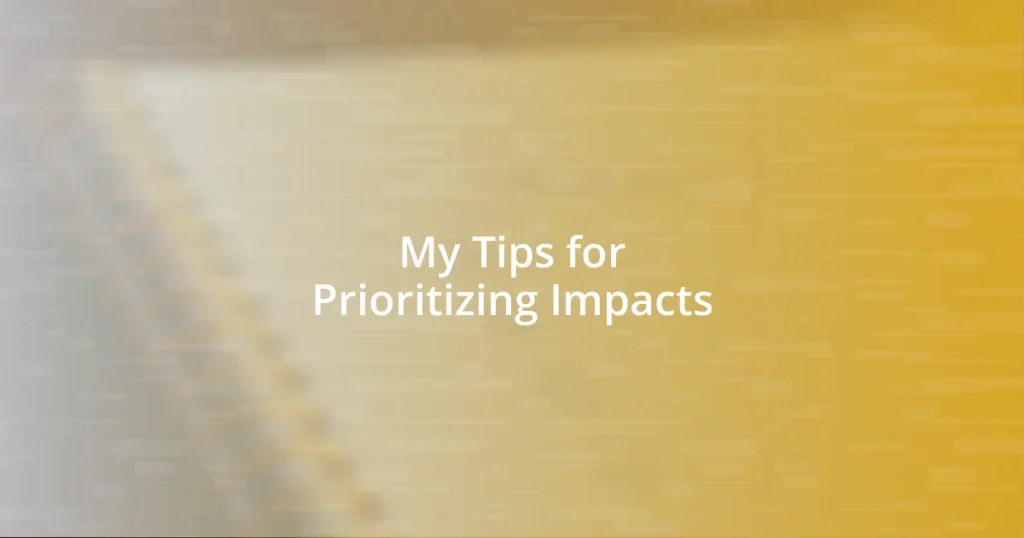Key takeaways:
- Impact prioritization aligns decision-making with personal values, making it essential for achieving significant long-term benefits.
- Utilizing a scoring system and metrics like KPIs, feedback surveys, and engagement metrics helps streamline decision-making and clarify priorities.
- Effective communication of impact decisions fosters transparency, trust, and engagement among team members, enhancing collaboration and ownership.

Understanding Impact Prioritization
Understanding impact prioritization is about recognizing what truly matters. I remember a time when I was overwhelmed with projects at work. It hit me then—without prioritization, I was essentially sailing without a compass, leading to frustration and burnout.
Consider the emotions tied to decision-making. I’ve often grappled with picking between two equally appealing opportunities. It’s like being at a buffet and wondering which dish will truly satisfy my hunger. The realization that prioritization aligns my decisions with my values made the process more intuitive and less stressful.
When I think about impact prioritization, I can’t help but question: how many of us chase tasks that don’t serve our ultimate goals? I’ve learned that by identifying both short-term wins and long-term outcomes, I can focus my energy on what delivers the most significant benefits. This clarity turns seemingly daunting decisions into achievable steps forward.

Identifying Key Areas of Impact
Identifying the key areas of impact in your work can be a game changer. I still recall a project where I spent days refining a presentation, only to realize that the audience was more interested in data visualization. It’s moments like those that highlight the necessity of pinpointing what resonates most with stakeholders. Knowing where to direct your efforts can transform how you approach your tasks.
When I set out to recognize these pivotal areas, I often start by reflecting on past experiences. A few years back, I was tasked with rolling out a new software tool. Initially, I focused on its technical features, but I soon discovered that my team was more concerned with usability. This realization encouraged me to adjust my focus, leading to higher adoption rates. It’s this responsiveness to the needs around us that really makes a difference.
Creating a comparison framework allows for a clearer view of various impacts. It’s interesting how easy it is to get lost in complex details, but organizing factors into identifiable segments gives a clearer perspective. I find that using a table to contrast different areas not only sharpens insights but also helps prioritize what will make the most significant impact.
| Area of Impact | Importance |
|---|---|
| User Experience | High |
| Feature Set | Medium |
| Cost Efficiency | High |

Assessing Impact with Metrics
Assessing impact with metrics turns abstract ideas into concrete assessments. I recall a project where we were unsure how to gauge our success. After exploring a range of metrics, we settled on user engagement and satisfaction scores. These metrics not only provided clarity but also directed our focus to where we truly needed improvement, illuminating the path forward.
To effectively assess impact, consider the following metrics:
- Key Performance Indicators (KPIs): Metrics that align directly with your overall objectives, such as conversion rates or retention rates.
- Feedback Surveys: Collecting user insights can reveal areas that need attention and improvement.
- Net Promoter Score (NPS): A measure of customer satisfaction that helps you understand loyalty and areas for growth.
- Engagement Metrics: Analyzing usage patterns helps spot where users derive the most value from your offerings.
Using these metrics helped me reshape strategies for subsequent projects, providing that essential piece of clarity that transforms scattered thoughts into actionable insights.

Creating a Impact Prioritization Matrix
Creating an Impact Prioritization Matrix can seem daunting, but I’ve found it to be a straightforward process once you break it down. I remember when I first attempted it; I was overwhelmed by the options. However, plotting each area of impact on a simple grid helped me visualize priorities and make decisions more confidently. For instance, I often categorize impacts by their potential benefit and the effort required. This method highlights what needs urgent attention versus what can wait.
In my experience, it’s essential to involve your team in the matrix creation process. When we worked on developing a new marketing strategy, I gathered input from colleagues with varying expertise. Their perspectives brought insights I hadn’t considered, enabling us to pinpoint initiatives that would resonate most with our audience. It’s amazing how collective brainstorming can transform a subjective matrix into a more objective tool.
Lastly, I recommend continuously revisiting and updating your matrix. I remember creating one for a product launch, and just a few weeks in, shifts in market trends required adjustments to our priorities. Asking questions like, “What’s changed since we last reviewed this?” keeps your decisions relevant and impactful. This adaptability has been vital in ensuring my priority list remains aligned with real-time needs.

Implementing a Scoring System
Implementing a scoring system can truly be transformative in how we prioritize impacts. I once faced a project decision that seemed impossible—too many options and not enough clarity. When I introduced a scoring system, rating each potential impact on a scale from 1 to 10 based on factors like urgency and importance, everything changed. It allowed me to sift through the noise and pinpoint which tasks deserved my attention first, streamlining the decision-making process significantly.
In practice, I learned it’s crucial to define clear criteria for scoring. For example, I once grouped impacts into categories like ‘financial gain,’ ‘stakeholder satisfaction,’ and ‘long-term sustainability.’ This not only provided a structured approach but also made discussions with my team far more productive. We could quickly evaluate each initiative and agree on priorities, which reinforced our commitment to the shared vision. Plus, who doesn’t love a quantifiable method of showing progress?
I also suggest keeping the scoring system dynamic. Picture this: I had a project where the initial scores changed dramatically after a key stakeholder provided new input. Instead of sticking to the original numbers stubbornly, we revisited our scoring, adapting to these insights much like you’d adjust a recipe based on feedback. Isn’t it fascinating how flexibility can lead to more robust outcomes? By embracing a fluid scoring system, we can truly ensure that our priorities reflect the evolving nature of our projects and the environments in which we operate.

Evaluating and Adjusting Priorities
Evaluating priorities is a critical step in making sure our efforts yield the best possible outcomes. I remember when I was deep into a project and realized I hadn’t revisited my priorities in weeks. It struck me that although I was busy, I wasn’t always busy with the right things. Taking a moment to step back and assess what truly mattered changed everything; I could pivot my focus and realign myself with our overarching goals.
One strategy I find invaluable is to regularly gather feedback from my team regarding our priorities. It’s easy to overlook fresh perspectives, especially when I’m immersed in a project. I once asked my colleagues for input during a quarterly review, and surprisingly, they highlighted several initiatives I had underestimated. That moment highlighted a vital truth: engaging others in evaluation not only brings in new ideas but also strengthens team collaboration and buy-in. Have you ever felt that a simple question can open up new avenues for thought? It’s remarkable how discussions can lead us to uncharted territories of opportunity.
Adjusting priorities isn’t merely about shifting tasks; it’s about being responsive to change. Once, I launched a campaign that was initially well-received, but a sudden competitor move shifted market dynamics overnight. I had to quickly reassess and adapt our priorities to stay competitive. This experience taught me that being flexible is essential. How often do we cling to a plan out of stubbornness, even when it no longer serves its purpose? I encourage you to embrace the idea that recalibrating your focus can often unlock greater success.

Communicating Impact Decisions Effectively
Communicating impact decisions effectively can be a game-changer, especially when it comes to fostering transparency and collaboration. I once led a project where the decision-making process felt shrouded in mystery. It was like trying to read a novel with half the pages missing. By proactively sharing the rationale behind our impact priorities with my team, I not only created clarity but also sparked a sense of ownership among everyone involved. Have you ever noticed how openness can transform a group dynamic? When everyone understands the reasoning, it cultivates trust and enthusiasm.
Crafting messages that resonate can also be tricky but is essential for effective communication. For instance, I experienced a turning point when I tailored my impact discussions to match the interests of my team. Instead of presenting dry data and rankings, I shifted my focus to stories illustrating how our projects would benefit specific stakeholders. It hit home for everyone—it’s amazing how personal narratives can bridge the gap between numbers and meaning. Do you ever think about how a story can leave a stronger impression than raw statistics? This realization made all the difference in engaging my team’s creativity and commitment to our mission.
Lastly, the method of communication matters just as much as the message itself. I found that using visual aids, like charts and infographics, provided a fresh perspective on our impacts. During one presentation, I displayed a simple graphic that highlighted the projected outcomes of our initiatives. The response was immediate; team members were energized and eager to contribute. I often ask myself: how can we make complex information more digestible? Incorporating visuals not only simplifies communication but also encourages participation, allowing everyone to grasp and discuss the implications of our decisions more effectively.















